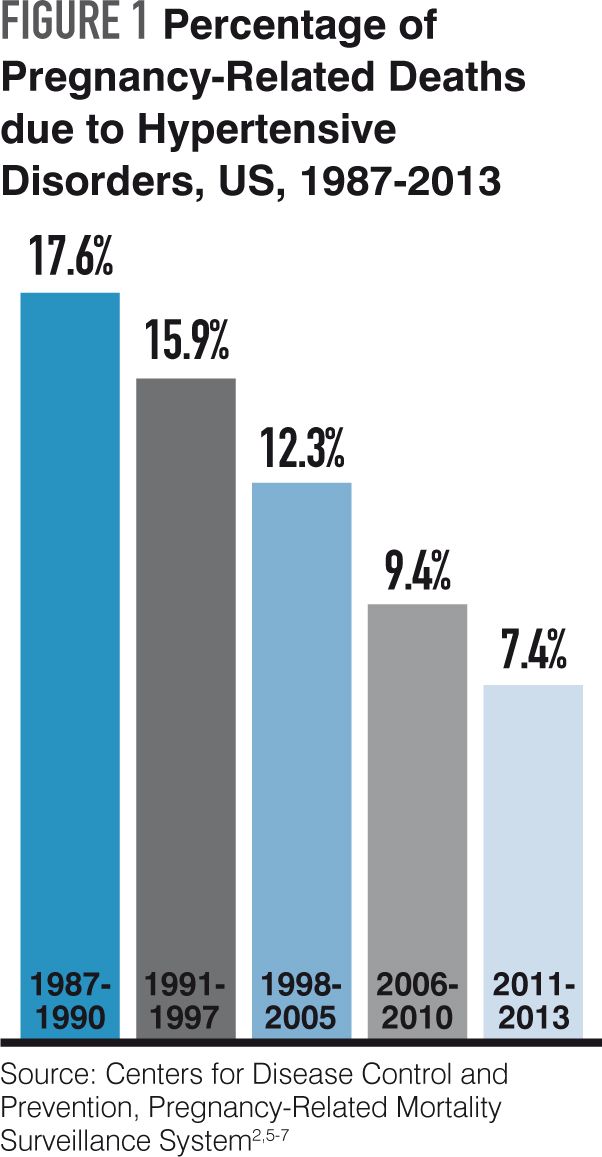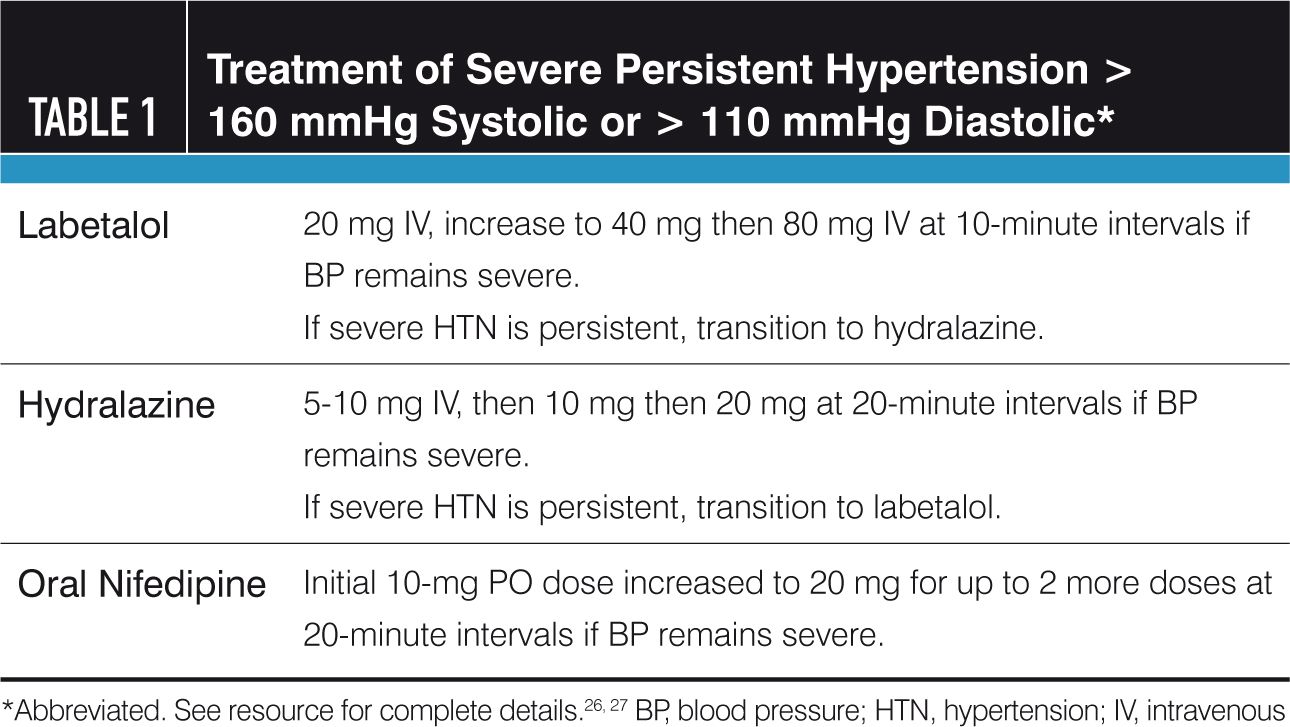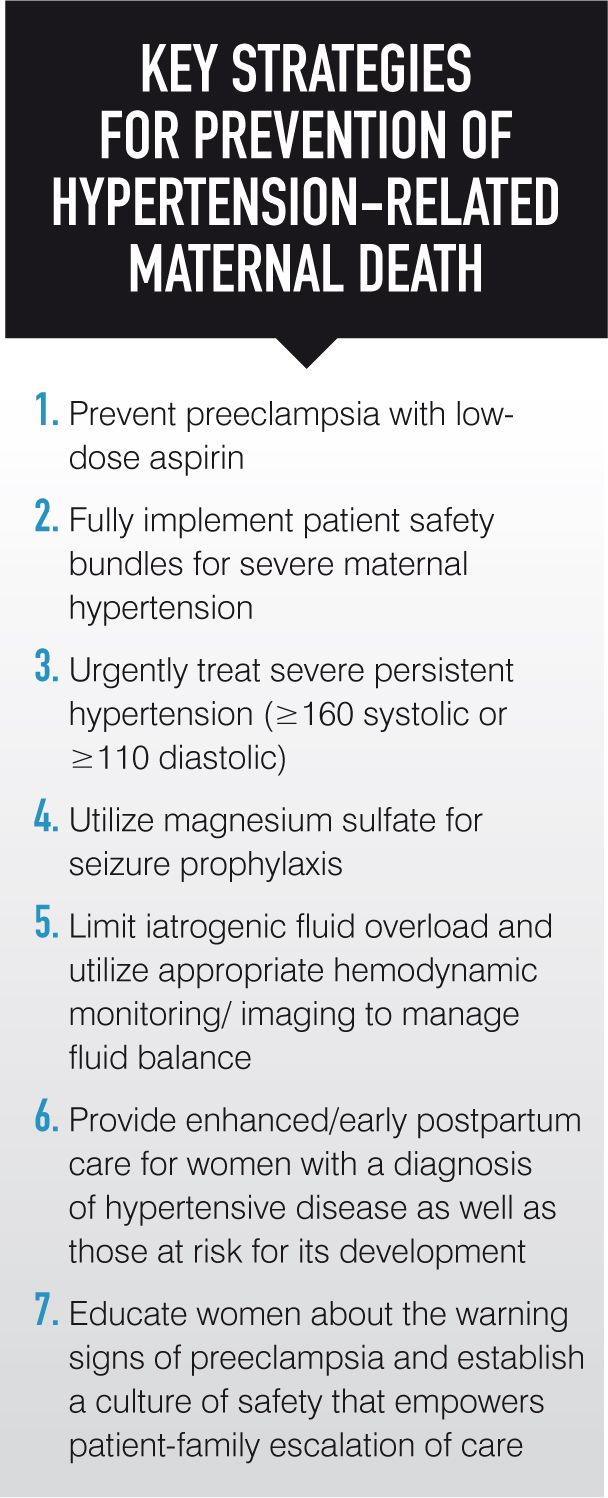Hypertensive disorders of pregnancy
Hypertensive disorders of pregnancy are among the leading contributors to maternal mortality worldwide. This review describes hypertension-related maternal mortality in the United States and key strategies to improve outcomes.

Charlene H. Collier, MD, MPH, MHS, FACOG

James N. Martin Jr., MD, FACOG, FRCOG, FAHA

" target="_blank">
Hypertensive disorders of pregnancy are among the leading contributors to maternal mortality worldwide. Approximately 30,000 deaths annually are attributed to hypertensive disorders including preeclampsia, eclampsia, and HELLP syndrome.1,2 In the United States, hypertension-related disorders account for approximately 7.4% of the almost 800 pregnancy-related deaths that occur each year.3 Women with preeclampsia/eclampsia are at 3 to 25 times the risk of severe pregnancy complications including placental abruption, disseminated intravascular coagulation (DIC), renal failure, pulmonary edema and aspiration pneumonia.4,5 Recent reviews suggest that up to 60% of hypertension-related maternal deaths are potentially preventable-there continue to be missed opportunities for appropriate, recommended care of severe maternal hypertension.6 This review describes hypertension-related maternal mortality in the United States and key strategies to improve outcomes.

Recent trends in hypertension-related maternal mortality
Between 1990 and 2015, maternal mortality increased in the United States by an estimated 27% while other developed nations have experienced persistent declines.7 During that time, however, the proportion of maternal deaths attributed to hypertensive disorders declined in the United States to 7.4%, falling behind cardiovascular diseases and other medical conditions (Figure 1).3,8-10 Based upon a recent report from the Centers for Disease Control and Prevention, hypertensive disorders accounted for 6.6% of deaths during pregnancy, 9.3% of deaths within 42 days of pregnancy, and 5.4% of deaths happening between 42 days and 1 year.11
Despite the declines in hypertension-related mortality, growing numbers of women are experiencing hypertensive disorders of pregnancy due to factors including the rising obesity epidemic, delayed childbearing and the use of assisted reproductive technologies. Between 1998 and 2006, the number of obstetric hospitalizations for hypertensive disorders significantly increased from 67.2 per 1,000 deliveries to 81.4 per 1,000 deliveries, mostly related to chronic hypertension (50% increase).12 Preeclampsia/eclampsia increased from 9.4 to 12.4 per 1,000 deliveries. Severe forms of preeclampsia were associated with 38% of acute renal failure hospitalizations and 19% to 24% of hospitalizations with complications involving DIC, acute respiratory distress syndrome (ARDS), cerebrovascular accidents, and pulmonary dysfunction/edema; 14% of the hospitalizations ended in death.
State-based reviews provide greater insight into hypertension-related maternal deaths.13 In California between 2002 and 2005, women dying from preeclampsia/eclampsia were more likely to be over 30 years old (67%), delivered preterm (61%), delivered by cesarean (83%) and/or primiparous (44% vs 21% for other mortality causes). The median timing of death was within 72 hours postpartum.6
The Florida Pregnancy-Associated Mortality Review summary of preeclampsia-related deaths (1999-2012) found an elevated risk of death among women over 35, non-Hispanic black women, those with limited prenatal care (5.7 vs 1.7 pregnancy-related deaths per 100,000 live births), obese women (8.1 vs 1.1 per 100,000 live births) and those delivering preterm (47 per 100,000 if< 28 weeks, 10.2 per 100,000 if 29-36 weeks’ gestation at birth). Forty-three percent of women with hypertension-related deaths experienced cerebrovascular hemorrhage and 17% had HELLP (hemolysis, elevated liver enzymes, low platelet count) syndrome.14
Postpartum risk
Several years ago, von Dadelszen and Magee astutely noted that delivery does not “cure” preeclampsia but initiates the process of recovery. Before complete recovery occurs, often there is evidence of a transient deterioration in key clinical parameters such as hypertension, thrombocytopenia and renal dysfunction. Thus, nearly 75% of maternal deaths associated with hypertensive disorders occur after birth with 41% occurring > 48 hours postpartum.15
For postpartum stroke, the period of highest risk occurs during the first 10- days after hospital discharge-58% of stroke cases occurred during this time.16 This included 53% of strokes among women with a known hypertensive disorder of pregnancy and 66% of strokes among patients with chronic hypertension without superimposed preeclampsia-the median times to presentation were 8.9 and 7.8 days, respectively. These data underscore the importance of close monitoring of patients with hypertensive disorders for the first 72 hours postpartum, reevaluating them within 7 to 10 days postpartum as recommended by the American College of Obstetricians and Gynecologists.17 Practices are encouraged to coordinate early postpartum care with blood pressure assessment in concert with patient education, the assurance of patient access to prescribed medication(s), and appropriate long-term care.18
Racial disparities in hypertension-related mortality
In comparison to US-born white women, nearly all other racial, ethnic and nativity groups face a greater risk of pregnancy-related mortality in the United States.19 Black women in the United States, in particular, are at significant risk of hypertension-related morbidity and mortality. Compared to white women, black women have nearly twice the incidence of preeclampsia (6.04 vs 3.75%), are more likely to suffer complications such as cardiac arrest, ARDS and heart failure and are over 3 times more likely to die.20,21 While variations in disease severity explain some of these disparities, differences in care delivery and variations in hospital quality can significantly impact risk of maternal death for black women.22Focus on severe persistent hypertension
Emergent treatment of severe acute-onset persistent hypertension (systolic BP > 160 mmHg or diastolic BP > 110 mmHg sustained > 15 minutes) constitutes an important component of high-quality obstetric care. Even in the absence of proteinuria, sudden development of sustained severe hypertension causes significant risk of hemorrhagic stroke and death. An estimated 25% to 45% of maternal strokes occur among patients with preeclampsia, eclampsia or HELLP syndrome.23 Severe systolic blood pressure is a consistent feature present before the onset of stroke in over 90% of women with hypertensive disorders.24

When reviewing factors contributing to preventable preeclampsia-related deaths, multiple state mortality reviews have identified instances of delayed medical staff response to both worrisome maternal symptoms and vital signs and inadequate staff knowledge and treatment of severe hypertension.6,25 There has been a national call to action for clinical practices to implement standardized systems to identify and treat severe maternal hypertension and associated disorders.26,27 A progressive algorithm for treatment within 60 minutes of confirmed measurement is recommended such as illustrated in the most recent ACOG Committee Opinion and otherwise summarized in Table 1. Staff should be educated on the algorithm including contraindications (i.e. labetalol contraindicated with asthma, heart disease or congestive heart failure) and patients informed about the goals of therapy, side effects and safety of these medications for breastfeeding mothers.
The recently released consensus bundle for severe hypertension includes guidance not only for standardization of antihypertensive therapy, but also for other important components of care such as discharge criteria, readmission criteria and guidance for postpartum outpatient surveillance all of which should be tailored to the unique maternity care setting.27 Use of such standardized treatment practices or safety bundles for maternal hypertensive disorders can significantly improve pregnancy outcomes.6,28 Shields demonstrated that compliance with blood pressure treatment recommendations increased from 50% to over 90% with a structured quality improvement initiative across 23 facilities. Importantly, this resulted in a 43% reduction in eclampsia and a 17% reduction in severe maternal morbidity.29

Magnesium sulfate to reduce risk of eclampsia-related mortality
Eclampsia complicates approximately 1 in 1,000 deliveries, affecting 0.5% to 3.0% of patients with preeclampsia.30 Women in developed nations who have regular prenatal care and delivery at tertiary care centers have mortality rates ranging between 0% to 1.8%, with the leading cause being intracranial hemorrhage. Magnesium sulfate can reduce the incidence of eclampsia by 42.6% and reduce severe maternal morbidity from 16.7% to approximately 2%.29,31 Because nearly half of eclamptic convulsions in the US occur before a mother can be hospitalized and treated with magnesium sulfate, providing enhanced prenatal and postpartum care to patients at risk for eclampsia is important.
Acute pulmonary edema in preeclampsia
Acute pulmonary edema is a leading cause of maternal death that complicates approximately 3% of preeclampsia cases, with up to 70% occurring in the postpartum period.32 Pulmonary edema is more common among hypertensive women who are postoperative, receiving excess intravenous fluids and magnesium sulfate infusion. Restrictive fluid management is generally recommended for patients with preeclampsia/eclampsia so that euvolemia is not exceeded.33 Women reporting dyspnea or demonstrating decreased oxygen saturation should be suspected of developing acute pulmonary edema and urgently evaluated, initially with bedside exam and chest radiography. Physical exam alone and the absence of audible rales is insufficient to rule out pulmonary edema.34 EKG, transthoracic echocardiography and CT scan may be needed to clarify diagnosis and guide therapy. Intravenous diuretic therapy such as furosemide 20 – 40 mg should be administered along with oxygen support and ongoing hemodynamic monitoring.
HELLP syndrome
When pregnancy is complicated by HELLP syndrome, there is increased risk of maternal death particularly from hemorrhagic stroke.35 The mortality rate associated with HELLP syndrome ranges from less than 1% to up to 30%, depending upon site of treatment and associated patient comorbidities.36 Isler found among 54 deaths from HELLP syndrome that the majority of women (71%) presented with symptoms of nausea, vomiting and epigastric pain and 42% had or developed eclampsia. The primary causes of maternal death included intracranial hemorrhage (26.4%), cardiopulmonary arrest (15.1%), respiratory failure (13.2%), hepatic hemorrhage (7.5%), hypoxic ischemic encephalopathy (7.5%), and DIC (5.7%).35 Several analyses have demonstrated that clinical symptoms are more predictive of poor outcomes than lab values alone.37
Preeclampsia prevention
To further reduce hypertension-related mortality, efforts must be undertaken to reduce the incidence of preeclampsia. Daily low-dose aspirin (81-150 mg) initiated between 12 and 24 weeks’ gestation has been shown in several score studies to reduce development of preeclampsia by 10% to 29%. In women with both moderate- and high-risk factors for preeclampsia, initiation of an aspirin regimen should be routine.38
Patient education and empowerment
It is critical for pregnant women to know the warning signs of preeclampsia, when to seek medical attention and to encounter a medical system that listens and responds to their needs. In the ProPublica and National Public Radio series on 134 maternal deaths in the United States in 2016, Lost Mothers, many families reported instances of dismissed or discounted patient complaints prior to the death of a loved one. Physicians are encouraged to provide specific education to women with and/or at risk of a severe gestational hypertensive disorder and include patient and family interviews as part of debriefs and state morbidity and mortality reviews. 39
Disclosures:
The authors report no potential conflicts of interest with regard to this article.
References:
- Lo JO, Mission JF, Caughey AB. Hypertensive disease of pregnancy and maternal mortality. Curr Opin Obstet Gynecol. 2013;25(2):124-132.
- Kassebaum NJ, Bertozzi-Villa A, Coggeshall MS, et al. Global, regional, and national levels and causes of maternal mortality during 1990-2013: a systematic analysis for the Global Burden of Disease Study 2013. Lancet. 2014;384(9947):980-1004.
- Creanga AA, Syverson C, Seed K, Callaghan WM. Pregnancy-Related Mortality in the United States, 2011-2013. Obstet Gynecol. 2017;130(2):366-373.
- Zhang J, Meikle S, Trumble A. Severe maternal morbidity associated with hypertensive disorders in pregnancy in the United States. Hypertens Pregnancy. 2003;22(2):203-212.
- Ghulmiyyah L, Sibai B. Maternal mortality from preeclampsia/eclampsia. Semin Perinatol. 2012;36(1):56-59.
- Main EK, McCain CL, Morton CH, Holtby S, Lawton ES. Pregnancy-related mortality in California: causes, characteristics, and improvement opportunities. Obstet Gynecol. 2015;125(4):938-947.
- MacDorman MF, Declercq E, Cabral H, Morton C. Recent Increases in the U.S. Maternal Mortality Rate: Disentangling Trends From Measurement Issues. Obstet Gynecol. 2016;128(3):447-455.
- Berg CJ, Atrash HK, Koonin LM, Tucker M. Pregnancy-related mortality in the United States, 1987-1990. Obstet Gynecol. 1996;88(2):161-167.
- Berg CJ, Chang J, Callaghan WM, Whitehead SJ. Pregnancy-related mortality in the United States, 1991-1997. Obstet Gynecol. 2003;101(2):289-296.
- Creanga AA, Berg CJ, Syverson C, Seed K, Bruce FC, Callaghan WM. Pregnancy-related mortality in the United States, 2006-2010. Obstet Gynecol. 2015;125(1):5-12.
- Building U.S. Capacity to Review and Prevent Maternal Deaths. Report from 9 maternal mortality review committees. http://reviewtoaction.org/Report_from_Nine_MMRCs. 2018.
- Kuklina EV, Ayala C, Callaghan WM. Hypertensive disorders and severe obstetric morbidity in the United States. Obstet Gynecol. 2009;113(6):1299-1306.
- Callaghan WM. State-based maternal death reviews: assessing opportunities to alter outcomes. Am J Obstet Gynecol. 2014;211(6):581-582.
- Hernandez L. Pregnancy-Related Deaths Due to Hypertensive Disorders 1999-2012. Florida Depart. of Health.
- von Dadelszen P, Magee LA. Preventing deaths due to the hypertensive disorders of pregnancy. Best Pract Res Clin Obstet Gynaecol. 2016;36:83-102.
- Too G, Wen T, Boehme AK, et al. Timing and Risk Factors of Postpartum Stroke. Obstet Gynecol. 2018;131(1):70-78.
- American College of Obstetricians and Gynecologists. Task Force on Hypertension in Pregnancy, American College of Obstetricians and Gynecologists. Hypertension in pregnancy. Washington, DC: American College of Obstetricians and Gynecologists; 2013.
- ACOG Committee Opinion No. 666: Optimizing Postpartum Care. Obstet Gynecol. 2016;127(6):e187-192.
- Creanga AA, Berg CJ, Syverson C, Seed K, Bruce FC, Callaghan WM. Race, ethnicity, and nativity differentials in pregnancy-related mortality in the United States: 1993-2006. Obstet Gynecol. 2012;120(2 Pt 1):261-268.
- Howell EA. Reducing Disparities in Severe Maternal Morbidity and Mortality. Clin Obstet Gynecol. 2018.
- Shahul S, Tung A, Minhaj M, et al. Racial Disparities in Comorbidities, Complications, and Maternal and Fetal Outcomes in Women With Preeclampsia/eclampsia. Hypertens Pregnancy. 2015;34(4):506-515.
- Howell EA, Egorova NN, Balbierz A, Zeitlin J, Hebert PL. Site of delivery contribution to black-white severe maternal morbidity disparity. Am J Obstet Gynecol. 2016;215(2):143-152.
- Lanska DJ, Kryscio RJ. Risk factors for peripartum and postpartum stroke and intracranial venous thrombosis. Stroke. 2000;31(6):1274-1282.
- Martin JN, Thigpen BD, Moore RC, Rose CH, Cushman J, May W. Stroke and severe preeclampsia and eclampsia: a paradigm shift focusing on systolic blood pressure. Obstet Gynecol. 2005;105(2):246-254.
- Geller SE, Koch AR, Martin NJ, Prentice P, Rosenberg D, Group IDoPHMMRCW. Comparing Two Review Processes for Determination of Preventability of Maternal Mortality in Illinois. Matern Child Health J. 2015;19(12):2621-2626.
- ACOG Committee Opinion No. 623: Emergent therapy for acute-onset, severe hypertension during pregnancy and the postpartum period. Obstet Gynecol. 2015;125(2):521-525.
- Bernstein PS, Martin JN, Barton JR, et al. National Partnership for Maternal Safety: Consensus Bundle on Severe Hypertension During Pregnancy and the Postpartum Period. Obstet Gynecol. 2017;130(2):347-357.
- Cleary KL, Siddiq Z, Ananth CV, et al. Use of Antihypertensive Medications During Delivery Hospitalizations Complicated by Preeclampsia. Obstet Gynecol. 2018;131(3):441-450.
- Shields LE, Wiesner S, Klein C, Pelletreau B, Hedriana HL. Early standardized treatment of critical blood pressure elevations is associated with a reduction in eclampsia and severe maternal morbidity. Am J Obstet Gynecol. 2017;216(4):415.e411-415.e415.
- Sibai BM. Diagnosis, prevention, and management of eclampsia. Obstet Gynecol. 2005;105(2):402-410.
- Altman D, Carroli G, Duley L, et al. Do women with pre-eclampsia, and their babies, benefit from magnesium sulphate? The Magpie Trial: a randomised placebo-controlled trial. Lancet. 2002;359(9321):1877-1890.
- Dennis AT, Solnordal CB. Acute pulmonary oedema in pregnant women. Anaesthesia. 2012;67(6):646-659.
- Anthony J, Schoeman LK. Fluid management in pre-eclampsia. Obstetric Medicine. 2013;6(3):100-104. doi:10.1177/1753495X13486896.
- Clark SL, Hankins GD. Preventing maternal death: 10 clinical diamonds. Obstet Gynecol. 2012;119(2 Pt 1):360–4.
- Isler CM, Rinehart BK, Terrone DA, Martin RW, Magann EF, Martin JN. Maternal mortality associated with HELLP (hemolysis, elevated liver enzymes, and low platelets) syndrome. Am J Obstet Gynecol. 1999;181(4):924-928.
- Sibai BM, Ramadan MK, Usta I, Salama M, Mercer BM, Friedman SA. Maternal morbidity and mortality in 442 pregnancies with hemolysis, elevated liver enzymes, and low platelets (HELLP syndrome). Am J Obstet Gynecol. 1993;169(4):1000-1006.
- Cavkaytar S, Ugurlu EN, Karaer A, Tapisiz OL, Danisman N. Are clinical symptoms more predictive than laboratory parameters for adverse maternal outcome in HELLP syndrome? Acta Obstet Gynecol Scand. 2007;86(6):648-651.
- Henderson JT, Whitlock EP, O’Connor E, Senger CA, Thompson JH, Rowland MG. Low-dose aspirin for prevention of morbidity and mortality from preeclampsia: a systematic evidence review for the U.S. Preventive Services Task Force. Ann Intern Med. 2014;160(10):695-703.
- Suplee PD, Kleppel L, Santa-Donato A, Bingham D. Improving Postpartum Education About Warning Signs Of Maternal Morbidity and Mortality. Nurs Womens Health. 2017;20(6):552-567.
S1E4: Dr. Kristina Adams-Waldorf: Pandemics, pathogens and perseverance
July 16th 2020This episode of Pap Talk by Contemporary OB/GYN features an interview with Dr. Kristina Adams-Waldorf, Professor in the Department of Obstetrics and Gynecology and Adjunct Professor in Global Health at the University of Washington (UW) School of Medicine in Seattle.
Listen
Study shows a healthy prenatal diet could be upstream obesity prevention strategy
December 26th 2024"Our findings support the recommendation of a healthy diet based on the current guidelines (as measured by the HEI) during pregnancy, since it may reduce patterns of infant growth outside reference ranges."
Read More
Early pregnancy cannabis use high in states with recreational legalization
November 11th 2024A population-based time-series analysis California before, during and after legalization show a rising trend in women using cannabis while pregnancy especially when the state has legalized the drug.
Read More

